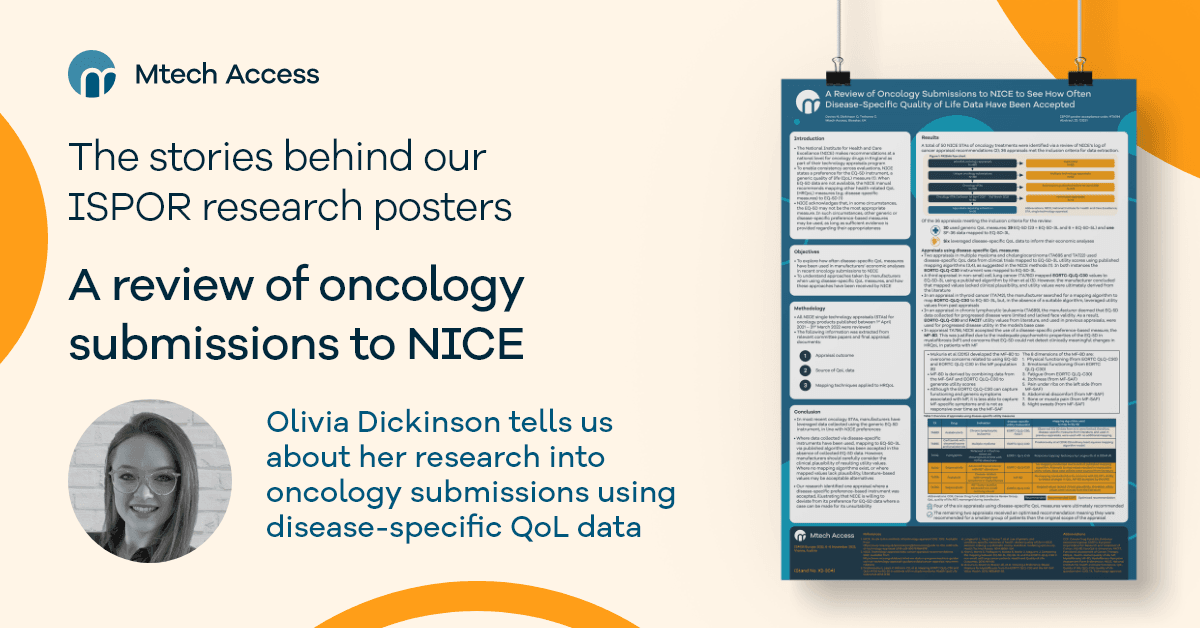
We speak to Olivia Dickinson (Associate Health Economist) to get the story behind the poster: ‘A Review of Oncology Submissions to NICE to See How Often Disease-Specific Quality of Life Data Have Been Accepted’. Olivia worked with Neil Davies (Senior Health Economist) and Catrin Treharne (Director – Health Economics), to research, develop and co-author the poster for presentation at ISPOR.
In all, we presented 7 independent research posters at ISPOR Europe, from 7th-9th November 2022. In this series of interviews we sit down with poster authors to learn a bit more about their research.

What topic does your poster explore?
For our ISPOR poster we decided to explore the use of disease-specific quality of life (QoL) measures in single technology appraisal submissions to the National Institute for Health and Care Excellence (NICE).
NICE guidelines state a preference for using a generic QoL measure called the EQ-5D. The EQ-5D assesses a patient’s health status across five dimensions:
- Mobility
- Self-care
- Usual activities
- Pain/discomfort
- Anxiety/depression
Generic QoL instruments such as the EQ-5D are designed to be applicable across a wide range of populations and interventions; however, the EQ-5D may not be capture key aspects of a health state for some specific disease areas. In such cases, other generic or disease-specific preference-based measures may be used, if enough evidence is provided to justify the use of these measures instead of the EQ-5D.
We decided to conduct a review of recent oncology submissions to NICE to see how often manufacturers used disease-specific QoL data, and how often such data were accepted.
What inspired you to pursue this topic?
In health economic evaluations, it is essential to capture the impact of an intervention on a patient’s health-related QoL (HRQoL) as accurately as possible.
Since its development, the EQ-5D has become the most widely used generic measure of HRQoL, with public bodies such as NICE adopting it as its preferred measure of HRQoL. However, this raises the question as to whether the widespread adoption of the EQ-5D has prevented the development and more frequent use of disease-specific measures, which may better capture HRQoL in some disease areas.
We focused on oncology, since the disease area is well-researched and there would therefore be a sufficient number of NICE submissions to review. Furthermore, due to the vast number of cancer types that have been identified, we believed there was an increased likelihood of disease-specific measures being used in some submissions.
How did you and your co-writers work together to conduct the research and develop the poster?
Once we’d identified the relevant oncology appraisals, Neil and I divided the review of these between us.
The review process consisted of reading the published committee papers to identify the HRQoL measure used to generate utility values for the economic analysis in each submission. If a disease-specific measure was used, we noted whether a mapping algorithm was used to map the data to the EQ-5D.
Once the results were consolidated and cross-checked, we began to develop our abstract and poster with support and input from Catrin.
For you, what was the most interesting aspect of your research?
Our research identified a disease-specific preference-based measured call the MF-8D. This is a disease-specific measure for patients with myelofibrosis (MF), which is a rare type of bone marrow cancer. Symptoms of MF include enlargement of the spleen; and non-specific symptoms, such as fatigue, weight loss, and night sweats.
The MF-8D was particularly interesting because it was derived by combining two existing measures:
- A generic cancer measure called the European Organisation for Research and Treatment of Cancer Quality of Life 30 Questionnaire (EORTC QLQ-C30), and
- An MF-specific measure called the Myelofibrosis-Symptom Assessment Form version 2.0 (MF-SAF 2.0)
The developers of the MF-8D argued that the EORTC QLQ-C30 does not cover important MF-specific symptoms. The MF-SAF 2.0 focuses on seven items of MF symptoms, such as abdominal discomfort, night sweats, and muscle pain. However, it was not considered sufficient for producing utility values. Therefore, different dimensions of the EORTC QLQ-C30 and MF-SAF 2.0 can be used to generate utility values for patients with MF.
I found the MF-8D particularly interesting because it was not a QoL measure I had heard of before. Furthermore, the MF-8D demonstrates that the process of collecting QoL is constantly evolving to ensure the well-being of patients is accurately captured.
Were the results as you anticipated when you began your research? Were there any surprises?
We expected the majority of submissions would use EQ-5D data since this is per the NICE guidelines. While the majority of submissions that did not use EQ-5D data attempted to use a mapping algorithm, some of these submissions resorted to using utility values obtained from published literature due to the mapped values lacking clinical plausibility.
Two of the appraisal submissions identified collected data using a disease-specific measure and then mapped the outcomes to the EQ-5D using a published algorithm. One of these appraisals was recommended, and the other appraisal received an optimised recommendation for a smaller group of patients than the original appraisal scope outlined.
I had expected most submissions that did not map their QoL data to the EQ-5D to not be recommended by NICE. However, the other four appraisals were also recommended, either as part of the cancer drugs fund or as an optimised recommendation.
What was your most important takeaway?
The most important takeaway is that our findings suggest that NICE is willing to deviate from its preference for EQ-5D data in oncology submissions. Nonetheless, manufacturers should still carefully explore ways of generating EQ-5D data since strong justification is required for deviating from the reference case.
What’s the next step for your research?
Our analysis only considered appraisals that were published between 1st April 2021–31st March 2022; therefore, I would like to apply our research to a broader range of oncology submissions.
Our research demonstrated EORTC-QLQ-C30 was the most commonly used disease-specific instrument. Expanding the number of appraisals to be reviewed would enable us to determine whether EORTC-QLQ-C30 has always been the most popular oncology-specific QoL measure or if there are other frequently used measures not captured in our research.
What have you learnt that you can apply to your future work?
Whilst I would always recommend the use of modelling approaches that align with the NICE reference case, our research has taught me that the absence of EQ-5D data in a clinical trial is not necessarily a barrier to reimbursement.
As a market access consultancy, we work with a wide range of clients that specialise in a variety of disease areas. Therefore, there will be cases where the EQ-5D may not be the most sensitive HRQoL instrument. As our research has demonstrated, disease-specific HRQoL measures will be accepted by NICE so long as sufficient justification is provided.
For future NICE submissions that I’m involved in, I will recommend that a comprehensive systematic review of HRQoL data is conducted to ensure the most appropriate data are selected and justified.
View the poster here.
If you would like to discuss this research with the poster authors, learn more about our health economists’ expertise in oncology , or discuss the best methodology for your NICE submission with our HTA experts, email info@mtechaccess.co.uk.


